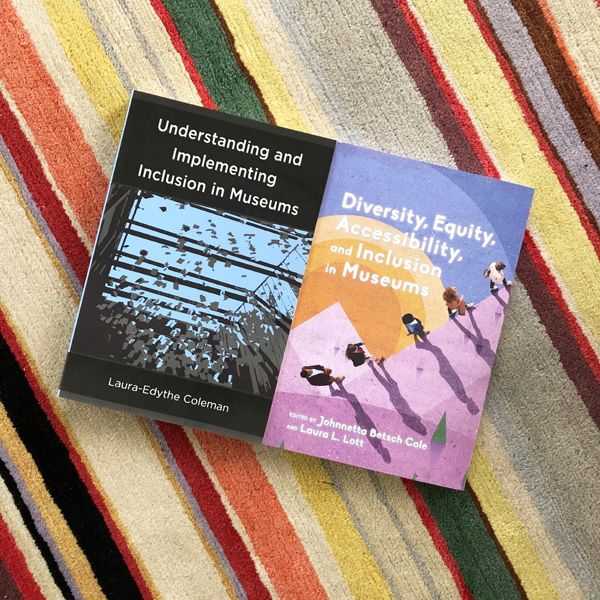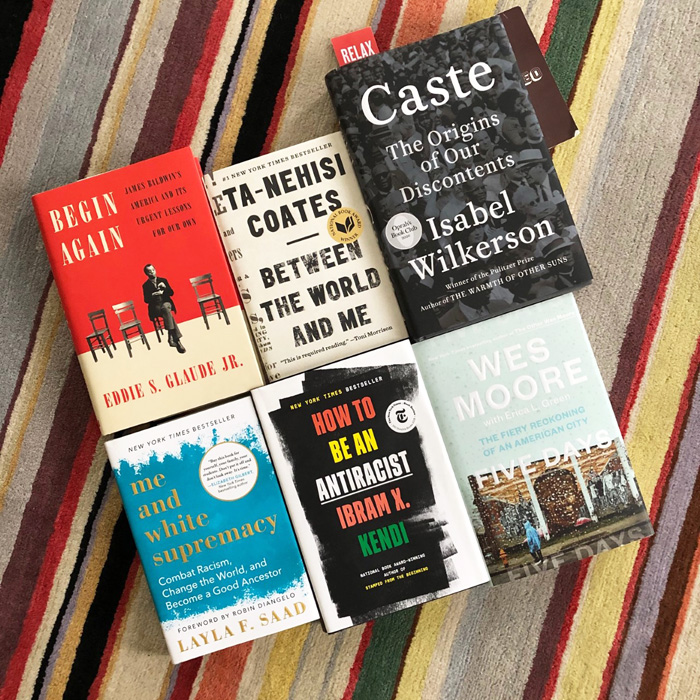Makeup Museum (MM) Musings is a series that examines a broad range of museum topics as they relate to the preservation, research and exhibition of cosmetics, along with my vision for a physical Makeup Museum. These posts help me think through how I'd run things if the Museum occupied a physical public space, as well as examine the ways it's currently functioning. I also hope that these posts make everyone see that just because the Makeup Museum does not have a physical space or official nonprofit designation, it is as valid as other museums, and more legitimate than many other profit-driven entities calling themselves "museums".
 Let me just say up front that the timing of this post has nothing to do with the Capitol insurrection that took place a few weeks ago, or the fact that Black History Month starts in two days. This is something that's been in the works for over a year, as it's extremely important to the Museum's mission and to me personally. After giving myself a crash course in diversity and inclusion, I feel as though I'm finally ready to write something a little more in-depth than the thoughts I jotted down back in June 2020. One of the Museum's primary goals is to present makeup and its history differently than what currently exists, and a big part of that is sharing previously undiscovered or underrepresented stories. So many of them concern BIPOC and LGBTQ+ histories, and it's important to tell them not just for diversity's sake but for history more generally.
Let me just say up front that the timing of this post has nothing to do with the Capitol insurrection that took place a few weeks ago, or the fact that Black History Month starts in two days. This is something that's been in the works for over a year, as it's extremely important to the Museum's mission and to me personally. After giving myself a crash course in diversity and inclusion, I feel as though I'm finally ready to write something a little more in-depth than the thoughts I jotted down back in June 2020. One of the Museum's primary goals is to present makeup and its history differently than what currently exists, and a big part of that is sharing previously undiscovered or underrepresented stories. So many of them concern BIPOC and LGBTQ+ histories, and it's important to tell them not just for diversity's sake but for history more generally.
This post will not go into detail regarding the obvious facts that 1. Despite good intentions, all museums are rooted in colonialism; 2. U.S. museums have a critical diversity problem; and 3. Diverse and inclusive museums are better in every way than non-inclusive spaces. Instead, it seeks to answer the following question: How can the Makeup Museum, in its current state, be as diverse and inclusive as possible? I don't have all the answers, but MM Musings are an exercise to think through the heavier issues and ponder how the Museum can be better – more of a journey than an endpoint. To help guide this installment of MM Musings I relied on these two books, along with the anti-racism books I purchased last year. I also looked at all the articles and other resources I could access for free online.
As I noted previously, there are unique challenges for a cosmetics museum to become a diverse and inclusive space. But that doesn't mean there's not room for improvement. If the Museum occupied a physical space and had paid employees (well-paid and with full benefits, of course, and while I hope they would not have a need for a union, they would absolutely be encouraged to form one if they want), it would no doubt have a diverse board and staff at all levels that would be treated as integral to the organization and not tokens, along with the other essentials such as diversity training for docents and consultants to continually evaluate the Museum's efforts and provide recommendations. In its current form, however, the primary focus in terms of diversity and inclusion is on the Museum's content and collection. Since there are no blueprints as to how to run an online cosmetics museum/blog whose existence and finances depend entirely on one person who is also not technically a museum professional, it's tricky to come up with a concrete plan of action for diversity and inclusion. But here's a start.
Diversify the collection.
Collecting Chinese, Japanese and Korean brands are not an issue, nor are ones founded or owned by LGBTQ+ people – there are plenty of those as well as artist/fashion collaborations – but Latinx and Indigenous brands and collabs remain somewhat elusive. I can write about my beloved Pai Pai but they no longer ship to the U.S., and I know of only a handful of other Latinx or Indigenous-owned brands. Contemporary Black-owned brands are easier to find than ever now so I will continue purchasing more from them, but it's still difficult to find many vintage pieces simply because there were so few compared to the big mainstream brands, none of which catered to BIPOC's needs until the 1960s or so (and even then their efforts continued to miss the mark.) I will continue to keep my eyes peeled and buy from BIPOC and LGBTQ+ brands as much as possible.
Diversify blog, IG and exhibition content.
- The Museum's collection may not be diverse enough right now, but that doesn't mean I can't write about objects or other pieces of makeup history related to BIPOC and LGBTQ+ communities, along with topics centered on ageism within the industry and people with disabilities. There are so many that are either have not been fully explored or not mentioned at all. One stumbling block remains: namely, I'm still not sure they're stories appropriate for a white, able-bodied, cis-het woman to tell. This is particularly important when discussing makeup used by Indigenous people, as in some cases it has a spiritual or religious purpose rather than beautification or self-expression. I'm afraid I don't have a solution other than to forge ahead and write about topics that may not be 100% appropriate but that are important. I think as long as I'm treating them in a sensitive manner and open to feedback and constructive criticism, it's better to share these histories even if they're from a non-BIPOC/LGBTQ+ person. One thing I eventually learned last summer was that being totally silent and not even attempting to diversify content is worse than trying and getting it wrong. I only hope I don't inflict any harm, but if I do, then I can always remove the post and do better the next time.
- Search for more BIPOC and LGBTQ+ artists and brands to feature on Instagram and in Color Connections.
- Exhibitions: How are BIPOC and LGBTQ+ represented in exhibitions? If they're not adequately represented, why? The solutions to this would normally be to have an exhibition that thoroughly incorporates diverse objects and voices, or have one focused on BIPOC and LGBTQ+ themes and ensure appropriate curation and oversight, e.g. not hiring someone who doesn't belong to those groups or has little to no knowledge about the topic at hand. This is a hurdle for the Makeup Museum as the founder and sole curator is not from an underrepresented group. The only thing I can do at the moment is choose exhibition topics in which marginalized people have adequate representation and make sure they see themselves in the exhibitions. It must be obvious that they're not niche visitors and that they are essential to the story the exhibition is telling. Theoretically I could explore whether anyone would be interested in co-curating or guest curating an exhibition focused on BIPOC or LGBTQ+, but as the Museum is entirely a labor of love and I'm unable to provide compensation, I'm sure as hell not asking someone from a marginalized group to curate or write for free. That brings me to my next point.
Identify fees for guest writers, curators and consultants and see if they are feasible without drastically cutting the budget for new acquisitions.
Like most of the initiatives I would love to pursue such as overhauling the website ($10-20k), purchasing archival storage containers ($1-2k), establishing a nonprofit (about $2-4k), getting a degree in museum or curatorial studies ($50k minimum) and purchasing and maintaining proper collections management software ($2k per year), I fear I would never be able to afford to hire professionals to work on the Museum with me even if I never bought another object, but it can't hurt to at least ask what their fees are. And who knows, perhaps I could even work out a plan whereby payments are due in installments rather than the full sum up front.
Further develop a community-focused, collaborative mindset.
Since its inception the Museum has operated in a mostly isolated environment. I'm not only a hardcore introvert and lifelong loner, but I always wanted to have my own space, something that I had full control over and without the involvement of anyone else. And that impulse is still quite strong. But I've also always wanted to educate, and though I'm not comfortable with it, being a resource means inviting people to help create it: by the public, for the public. Community for the Museum largely means either makeup aficionados/professionals or the local geographic area. I've always asked blog visitors to respond to my posts, and starting with the Stila girls exhibition in 2019, I began asking visitors to submit memories, photos or anything else they'd like to share to be incorporated into the exhibition. Lately I started investigating how the Museum might be able to collaborate with local museums, schools and historical centers – obviously I've considered pitching a pop-up exhibition at their spaces for over a decade now, but I realized I have to be more mindful of the approach. There's no way an organization is going to agree to host or be involved with an outside museum offering a pop-up exhibition if it has nothing to do with their mission or at least their collections. The goal, it seems, is to match interests. For example, the Maryland Center for History and Culture would be more interested in an exhibition on a history of Baltimore beauty parlors than, say, a display of rose-themed makeup, because their mission and collection have nothing to do with botany or natural history but is focused on the state of MD. I think there are ways in which the Museum can engage with both the makeup and local communities, and become more diverse and inclusive in doing so.
Establish metrics for the Museum's collection and content and share them publicly.
To keep any organization accountable in their diversity and inclusion efforts, it's necessary to track measurable outcomes of said efforts. Museums and Race's report card gave me the idea to develop one for the Museum based on the steps listed above. It would be updated annually each January and indicate the progress or maintenance of goals, which are as follows:
- Increase the number of posts that focus on or incorporate BIPOC and LGBTQ+ makeup and related topics (for example, the "multicultural" makeup of the '90s). Originally I wanted to follow U.S. demographics and keep a strict 60/40 split in which 40% of posts would be BIPOC-focused, with 18% Latinx topics/artists/brands, 15% Black, 6% Asian and 1% Indigenous. Alas, after crunching some numbers I realized that it would be impossible unless I both greatly scaled back the number of Asian-focused posts and hired or collaborated with BIPOC/LGBTQ+, and there's no telling if I will be able to achieve the latter. So for now, I'm going to take stock of what was written in 2020 and plan on more diverse posts in 2021. In terms of Instagram, taking a cue from the 15% pledge, my goal is to ensure at least 15% of IG posts feature Black makeup history, artists, models or Black-owned brands. I've been doing 11% since June (or 1 out of every 9 posts) and it has proved challenging. It's difficult because I don't want to repeat the same brands, models or artists ad nauseam and also want to provide meaningful and unique content, i.e. I don't want to toss up some ad that people have seen a thousand times before, especially without offering any new insight, just because I need to fill a quota that I set. Representation is critical, but can easily veer into tokenism. Having said that, I'd still like for 1 post out of every 6 (or 17%) to have Black-focused content and I'm working on how I can do that without blindly regurgitating things that are readily available and well-known. I'm also going to count other topics towards this goal even if they don't show a Black model or brand. For example, I have a bottle of Revlon's Touch and Glow foundation from the early 1950s in the deepest shade they made up until about 1957. As you may have guessed, it's medium toned at best. This is an example of how mainstream brands simply did not care about the needs of BIPOC customers, especially Black ones. I'm still not sure how to handle other demographics, however; as noted above, Latinx and Indigenous brands, artists and topics are somehow more difficult to find than Black ones. Nevertheless, Instagram makes it easy to track so I will take stock of 2020's posts and work on at least increasing the number of posts involving these groups.
- Increase the number of Museum objects from BIPOC-owned brands. I will keep track of what was acquired each year and work out the proportion of objects that came from BIPOC-owned brands. Then monitor those numbers each year to ensure they increase. For example, I purchased 22 makeup ads in 2020 and 6 of them were from Black-owned brands or featured Black models. So this year, let's say I purchase 22 ads again, 7 or more of them should be from BIPOC-owned brands or feature BIPOC models. The acquisition of objects from white-owned brands will still soundly outpace BIPOC-owned ones, especially for vintage pieces, but the goal is to increase that number and work towards a bigger percentage of BIPOC-owned objects in the collection.
- Track the number of BIPOC and LGBTQ+ people or organizations I reached out or donated to, along with community organizations. While nothing may come of these attempts on my part to collaborate with them, I feel it's important to at least get in touch. And there are plenty of BIPOC and LGBTQ individuals and organizations that can use donations.
- Ensure all exhibitions meaningfully represent BIPOC and LGBTQ+ individuals and brands, and if not, discuss why.
I think this sort of report card is more valuable than some bland diversity statement. Most of the statements I found lacked substance – they were just a bunch of jargon with no actionable steps outlined.
The Museum's diversity efforts are ongoing, of course. And I plan on tackling the related topics of social change and accessibility as future installments of MM Musings. But this is a beginning of a shift towards meaningful action. Thoughts? I'm off to create a report card for 2020 so I will have something to compare 2021 to.

